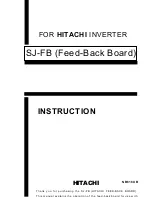
3 - English
IMPACT WRENCH SAFETY WARNINGS
Hold the power tool by insulated gripping surfaces,
when performing an operation where the fastener may
contact hidden wiring.
Fasteners contacting a “live” wire
may make exposed metal parts of the power tool “live”
and could give the operator an electric shock.
Wear ear protectors with impact wrenches.
Exposure
to noise can cause hearing loss.
Know your power tool. Read operator’s manual care-
fully. Learn its applications and limitations, as well as
the specific potential hazards related to this power
tool.
Following this rule will reduce the risk of electric
shock, fire, or serious injury.
Always wear eye protection with side shields marked
to comply with ANSI Z87.1 when assembling parts,
operating the tool, or performing maintenance.
Fol-
lowing this rule will reduce the risk of serious personal
injury.
Protect your lungs. Wear a face or dust mask if the
operation is dusty.
Following this rule will reduce the
risk of serious personal injury.
Protect your hearing. Wear hearing protection espe-
cially during extended periods of operation.
Following
this rule will reduce the risk of serious personal injury. If
at any time you become uncomfortable or the length of
your task is long, hearing protection is recommended.
Battery tools do not have to be plugged into an elec-
trical outlet; therefore, they are always in operating
condition. Be aware of possible hazards when not
using your battery tool or when changing accessories.
Following this rule will reduce the risk of electric shock,
fire, or serious personal injury.
Do not place battery tools or their batteries near fire
or heat.
This will reduce the risk of explosion and pos-
sibly injury.
Do not crush, drop or damage battery pack. Do not
use a battery pack or charger that has been dropped
or received a sharp blow.
A damaged battery is subject
to explosion. Properly dispose of a dropped or damaged
battery immediately.
Batteries can explode in the presence of a source
of ignition, such as a pilot light.
To reduce the risk of
serious personal injury, never use any cordless product
in the presence of open flame. An exploded battery can
propel debris and chemicals. If exposed, flush with water
immediately.
Under extreme usage or temperature conditions, bat-
tery leakage may occur. If liquid comes in contact with
your skin, wash immediately with soap and water. If
liquid gets into your eyes, flush them with clean water
for at least 10 minutes, then seek immediate medical
attention.
Following this rule will reduce the risk of seri-
ous personal injury.
Save these instructions.
Refer to them frequently and
use them to instruct others who may use this tool. If you
loan someone this tool, loan them these instructions also.
GENERAL POWER TOOL SAFETY WARNINGS
performed.
Use of the power tool for operations different
from those intended could result in a hazardous situation.
Keep handles and grasping surfaces dry, clean and
free from oil and grease.
Slippery handles and grasping
surfaces do not allow for safe handling and control of the
tool in unexpected situations.
BATTERY TOOL USE AND CARE
Recharge only with the charger specified by the
manufacturer.
A charger that is suitable for one type
of battery pack may create a risk of fire when used with
another battery pack.
Use power tools only with specifically designated
battery packs.
Use of any other battery packs may create
a risk of injury and fire.
When battery pack is not in use, keep it away from
other metal objects, like paper clips, coins, keys, nails,
screws or other small metal objects, that can make a
connection from one terminal to another.
Shorting the
battery terminals together may cause burns or a fire.
Under abusive conditions, liquid may be ejected from
the battery; avoid contact. If contact accidentally
occurs, flush with water. If liquid contacts eyes,
additionally seek medical help.
Liquid ejected from the
battery may cause irritation or burns.
Do not use a battery pack or tool that is damaged or
modified.
Damaged or modified batteries may exhibit
unpredictable behavior resulting in fire, explosion, or risk
of injury.
Do not expose a battery pack or tool to fire or
excessive temperature.
Exposure to fire or temperature
above 265°F may cause explosion.
Follow all charging instructions and do not charge the
battery pack or tool outside the temperature range
specified in the instructions.
Charging improperly or at
temperatures outside the specified range may damage
the battery and increase the risk of fire.
SERVICE
Have your power tool serviced by a qualified repair
person using only identical replacement parts.
This
will ensure that the safety of the power tool is maintained.
Never service damaged battery packs.
Service
of battery packs should only be performed by the
manufacturer or authorized service provider.




































